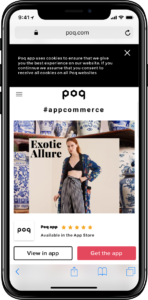Understanding the paradox of modern shoppers

As the modern shopper shifts to their mobile devices, retailers are having to deal with the reality that the web browser, a medium on which they have comfortably relied upon since the inception of ecommerce, is sinking deeper and deeper into a quicksand from which there will be no return.
The problem with mobile
The predictatory statistics of how traffic will shift from desktop to mobile as quoted by trusted sources from two or three years were seen to be pessimistic. Now, there is no doubt – mobile is the main traffic channel and there is no sign of anything changing or slowing its dominance.
But, just as Captain Smith could foresee his doom whilst being stood aboard the bridge of RMS Titanic as she took on a terminal amount of water, any retailer who has their finger on the pulse of their online performance should have a strong presentiment with regards to their mobile web performance.
This presentiment will come in the knowledge of how mobile websites convert extremely poorly compared to the glory days of desktop based web browsers. In fact, our data suggests desktop converts 3x better than mobile websites
When it comes down to mobile web versus desktop conversion, you can pretty much discount most factors such as price, brand, trust etc., as they remain the same across channels. What does change, however, is the user experience. Mobile websites take desktop content and it’s user journey and try and squeeze and squash it onto a mobile screen. Worse still, they have even less screen than usual due to the hijack by the URL section, the cookies disclaimer and often a pop up window.
 |
 |
The poor user experience that mobile websites deliver doesn’t only affect conversion, but a brands reputation too.
Anyhow, the ship hasn’t sunk yet and there are some fixes. One will plug the leak and the other will help a business to take off.
Fix #1 – Plug the leak
Retailers, you have the same amount of customers as before but only 1 in 3 of them is converting on mobile web in comparison to the desktop glory days. A fix is to fill the funnel more. By pushing 3x as many customers through the top of the funnel you’ll match the drop off in conversion (of course if it was that easy, you’d be doing it already!)
Pros:
- This approach maintains revenue
- Find new customers
Cons:
- Customer acquisition is expensive
- Customer experience on mobile web is still poor, this will continue to negatively affect the retailers brand
Fix #2 – Get ready for take off
Get an app.
In most cases, apps convert just as well as desktop. It also opens up an entire new channel to engage with your customers via native tools such as push notifications and spotlight search.
Pros:
- Our platform has shown that apps convert 2x better than mobile web so it solves your mobile web conversion issue
- Massively improved user experience which protects brands equity
- Push notifications defy the issues presented by GDPR affecting email marketing
Cons:
- Like any new technology, launching an app requires an initial investment
To summarise, mobile shoppers are here to stay. We’ve seen retailers spend vast sums of money to improve their mobile websites, or launch PWA’s only for the performance to be surpassed by a native app that launched in weeks. As technology like visual search, augmented reality and beacons continues to evolve, can any retailer really afford to be ignoring where their best customers want them to be?
If your retail business is ready for take off, get in touch with our team to find out how the Poq platform can help you launch.
Reported by Andy Whyte


